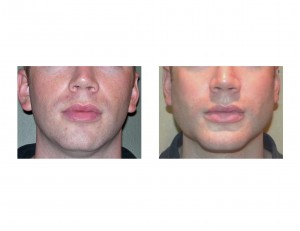The shape and dimensions of the chin has a huge impact on the appearance of the lower face. It is well known that weak vs strong chins give off different impressions of one’s personality, even though these impressions may not really be true. Most commonly, a ‘weak’ chin is treated by an implant which is based almost solely on an artistic assessment of increasing the amount of horizontal projection. But horizontal projection alone is but one dimension of a well proportioned and attractive chin and other dimensions needs to be assessed before surgery as well.
How is a chin assessed before surgery? How is a dimensional chin analysis done? The classic teaching is that one chin’s point should fall on a vertical line drawn down from the glabella on the Frankfort horizontal plane, particularly for a male. This is, of course, just a horizontal assessment. The vertical height of the lower third of the face and chin should be 1/3 of total facial height from the subnasale (base of the nose) down to the menton point. (bottom of the chin) This determination can be done in both the horizontal and frontal views. The width of the chin, however, is the obscure measurement and is not necessarily determined by the classic dividing the face into vertical 1/5s. There are no real established standards set for chin width, like anthropormetrics as done for chin height and length.
While the aesthetics of chin width are open to subjective assessment, there are some anatomic guidelines to use. The width of the chin in men is most aesthetically pleasing (stronger appearance) when it assumes one of two shapes. The first is that the squareness of the chin lies inside a vertical line drawn down from the corners of the mouth. This can be a good shape if one has noticeable jaw angle flare. This creates a jaw line with four distinct points in the frontal view. More square chin widths are also very acceptable but this width should never exceed a vertical line drawn from the center of the pupils in males. This is the greatest amount of chin squareness a man should have less they look cartoonish.


Dr. Barry Eppley
Indianapolis, Indiana


